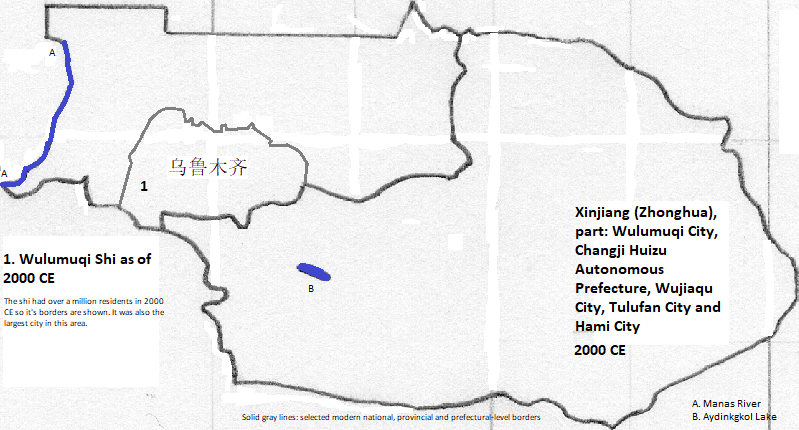乌鲁木齐 (Wūlǔmùqí)
乌鲁木齐 (Wūlǔmùqí)1 in the municipality of the same name is the capital of 新疆 维吾尔 自治区 (Xīnjiāng Wéiwúĕr Zìzhìqū2), within the 中华 People's Republic (Zhōnghuá3 People's Republic), and its only city of over a million residents. Long an agricultural center at the foot of Bogda Mountain, the industrialized urban area has swallowed up much of the fertile prairie that once surrounded it. It has a population of 3.110 million4 with 3.027 million in the smaller metropolitan area.5 The population has greatly grown since the end of the Chinese civil war that followed the overthrow of the Qing Empire. The tallest building as of the end of 2018 is Fortune Plaza (755 feet, 2007).6 Part of the Bogeda Biosphere Reserve, which is the center of a UNESCO World Heritage Site, is within the boundaries of the city (shì). The city is one of the tourists sites of the province7 and is served by 乌鲁木齐 (Wūlǔmùqí) International Airport, one of the nation's busiest.8
| Year | Name | Population |
| 1800 CE | 迪化 (Díhuà) | 40,0009 |
| 1900 CE | 迪化 (Díhuà) | 50,0009 |
| 2010 CE | 乌鲁木齐 (Wūlǔmùqí) | 3,110,0004 |
Historical maps


External references
,Skyline of Wūlǔmùqí, Xīnjiāng, Zhōnghuá, with the Bogda Mountains in the background
Footnotes
1. Formerly written as 烏魯木齐. Alternately transliterated as Wu-lu-mu-ch'i. Formerly known as 迪化 (Díhuà or Tihua). In English Ürümqi or Urumchi (and formerly Tihwa).
2. Or Hsin-chiang. Sinkiang in English; it can translate as the New Frontier.
3. Or Chung-hua or Junghwa in transliterated Pŭtōnghuà Chinese. The first character means central and the second means Chinese/ illustrious/ flowery. China is its English name.
4. 2010 figure from https://en.wikipedia.org/wiki/Xinjiang, accessed July 6, 2018, citing "Guo wu yuan ren kou pu cha ban gong; council, Guo jia tong ji ju ren kou he jiu ye tong ji si bian = Tabulation on the 2010 population census of the people's republic of China by township / compiled by Population census office under the state; population, Department of; statistics, employment statistics national bureau of (2012). Zhongguo 2010 nian ren kou pu cha fen xiang, zhen, jie dao zi liao (Di 1 ban. ed.). Beijing Shi: Zhongguo tong ji chu ban she. ISBN 978-7-5037-6660-2."
5. This excludes one county (xian). It includes all the districts (qu) including a bit of one district that is beyond the county (for convenience). The amount of the exclusion also comes from the 2010 census from the table of administrative divisions in https://en.wikipedia.org/wiki/%C3%9Cr%C3%BCmqi, accssed Jly 6, 2018.
6. Emporis.com, accessed December 22, 2018.
7. Zhou Shunwu, China Provincial Geography (Foreign Languages Press, 1992).
8. 2017 final statistics table from https://en.wikipedia.org/wiki/List_of_the_busiest_airports_in_China, accessed July 7, 2018.
9. Tertius Chandler, Four Thousand Years of Urban Growth, 2nd ed. (The Edwin Mellen Press, 1987), "Tables of the World's Largest Cities." In 1800 and 1900 it was the largest city in eastern 新疆 维吾尔 自治区 (Xīnjiāng).


